Subaru Legacy 2023 Continuously Variable Transmission Touring XT
A sophisticated Continuously Variable Transmission (CVT) is included in the 2023 Subaru Legacy Touring XT to go along with its potent 2.4-liter turbocharged BOXER engine. This CVT is notable for its smooth, fluid acceleration and improved fuel efficiency, continuously varying the gear ratio to best suit the driving conditions. With its manual mode and paddle shifters, it gives drivers the option to experience more exciting driving with simulated gear shifts. The CVT contributes to the Legacy Touring XT’s reputation for performance, comfort, and dependability by ensuring consistent and efficient power distribution throughout a range of driving circumstances when paired with Subaru’s symmetrical all-wheel drive system. Drivers looking for a mix between power, efficiency, and driving enjoyment will find the car appealing due to its blend of dynamic engine performance and cutting-edge transmission technology.
2024 Subaru Legacy Specs, Price, Features, Mileage (Brochure)
Continuously variable transmission
WARNING
Do not shift from the “P” or “N” position into the “D” or “R” position while depressing the accelerator pedal. This may cause the vehicle to jump forward or backward.
CAUTION
- Observe the following precautions. Otherwise, the transmission could be damaged.
- Shift into the “P” or “R” position only after the vehicle has completely stopped.
- Do not shift from the “D” position into the “R” position or vice versa until the vehicle has completely stopped.
- Do not race the engine for more than 5 seconds in any position except the “N” or “P” position when the brake is applied or when chocks are used in the wheels. This may cause the transmission fluid to overheat.
- Never move the vehicle as follows. Doing so may result in an unexpected accident or malfunction.
- Moving rearward by inertia with the select lever set in a forward driving position.
- Moving forward by inertia with the select lever set in the “R” position.
- When parking the vehicle, first securely apply the parking brake and then place the select lever in the “P” position. Avoid parking for a long time with the select lever in any other position as doing so could result in a dead battery.
Continuously variable transmission features
The continuously variable transmission is electronically controlled and provides an infinite number of forward speeds and 1 reverse speed. It also has a manual mode or an “L” position.
NOTE
- When the engine coolant temperature is still low, the transmission will shift at higher engine speeds than when the coolant temperature is sufficiently high in order to shorten the warm-up time and improve driveability. The gearshift timing will automatically shift to the normal timing after the engine has warmed up.
- Immediately after the transmission fluid is replaced, you may feel that the transmission operation is somewhat unusual. This results from the invalidation of data that the onboard computer has collected and stored in memory to allow the transmission to shift at the most appropriate times for the current condition of your vehicle. Optimized shifting will be restored as the vehicle continues to be driven for a while.
- continuous heavy load conditions such as when towing a camper or climbing a long, steep hill, the engine speed or the vehicle speed may automatically be reduced. This is not a malfunction. This results from the engine control function maintaining the cooling performance of the vehicle. The engine and vehicle speed will return to a normal speed when the engine is able to maintain the optimum cooling performance after the heavy load decreases. Driving under a heavy load must be performed with extreme care. Do not try to pass a vehicle in front when driving on an uphill slope while towing.
- The continuously variable transmission is a chain-type system that provides superior transmission efficiency for maximum fuel economy. At times, depending on varying driving conditions, a chain operating sound may be heard that is characteristic of this type of system.
- Place the shift boot to the original position after it is lifted. If the select lever is operated with the shift boot in the rolled-up position, the shift boot may have tension and it may disturb the `select lever operation.
Select lever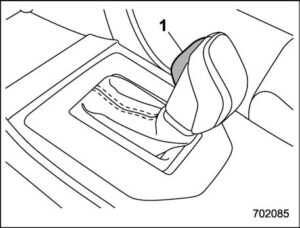
- Select lever button
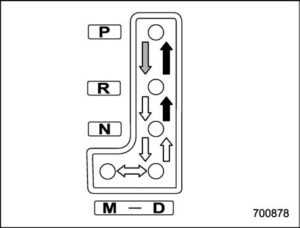
- With the brake pedal depressed, shift while pressing the select lever button in
- Shift while pressing the select lever button in Shift without pressing the select lever
The select lever has four positions, “P”, “R”, “N”, and “And d” and also has a manual gate for using the manual mode.
NOTE
- For some models, to protect the engine while the select lever is in the “P” or “N” position, the engine is controlled so that the engine speed may not become too high even if the accelerator pedal is depressed hard.
- When you change the select lever position, make sure to move the select lever firmly to the selected position.
P (Park)
This position is for parking the vehicle and starting the engine. In this position, the transmission is mechanically locked to prevent the vehicle from rolling freely. When you park the vehicle, first apply the parking brake firmly, then shift into the “P” position. Do not hold the vehicle with only the mechanical friction of the transmission. To shift the select lever from the “P” position to any other position, you should depress the brake pedal fully then move the select lever. This prevents the vehicle from lurching when it is started.
R (Reverse)
This position is for backing the vehicle. To shift from the “N” to “R” position, stop the vehicle completely then move the lever to the “R” position while pressing the select lever button in. When the ignition switch has been turned to the “ACC” position, the movement of the select lever from the “N” to “R” position is only possible by depressing the brake pedal.
N (Neutral)
This position is for restarting a stalled engine. In this position, the transmission is neutral, meaning that the wheels and transmission are not locked. Therefore, the vehicle will roll freely, even on the slightest incline unless the parking brake or foot brake is applied. Avoid coasting with the transmission in neutral. Engine braking has no effect in this condition.
WARNING
Do not drive the vehicle with the select lever in the “N” (neutral) position. Engine braking has no effect in this condition and the risk of an accident is consequently increased.
D (Drive)
This position is for normal driving. The transmission shifts automatically and continuously into a suitable gear according to the vehicle speed and the acceleration you require. Also, while driving up and down a hill, the transmission assists and controls the driving performance and engine braking while corresponding to the road grade. When more acceleration is required in the “D” position, depress the accelerator pedal fully to the floor and hold that position. The transmission will automatically downshift. In this case, the transmission will operate like a conventional automatic transmission. When you release the pedal, the transmission will return to the original gear position. For models with manual mode, if one of the shift paddles behind the steering wheel is operated while driving in the “D” position, the transmission will temporarily switch to the manual mode. In this mode, you can shift into any gear position using the shift paddles. For details about the manual mode, refer to “Selection of manual mode” p373. Once the vehicle speed stabilizes, the transmission will switch from the manual mode back to the “D” position for normal driving.
While climbing a grade
When driving up a hill, the undesired upshift is prevented from taking place when the accelerator is released. This minimizes the chance of subsequent downshifting to a lower gear when accelerating again. This prevents repeated upshifting and down-shifting resulting in a smoother operation of the vehicle.
NOTE
The transmission may downshift, depending on the way the accelerator pedal is depressed to accelerate the vehicle again.
Shift lock function
- The shift lock function helps prevent the improper operation of the select lever.
- The select lever cannot be operated unless the ignition switch is turned to the “ON” position and the brake pedal is depressed.
- The select lever cannot be moved from the “P” position to any other position before the brake pedal is depressed. Depress the brake pedal first, and then operate the select lever.
- Only the “P” position allows you to turn the ignition switch from the “ACC” position to the “LOCK”/“OFF” position and remove the key from the ignition switch.
- if the ignition switch is turned to the “ACC” position while the select lever is in the “N” position, the select lever may not be moved to the “P” position without depressing the brake pedal and pressing the select lever button.
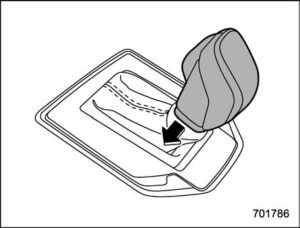
Shift lock release
If the select lever cannot be operated, turn the ignition switch back to the “ON” position then move the select lever to the “P” position with the select lever button pressed and the brake pedal depressed. If the select lever does not move after performing the above procedure, check and confirm the following and release the shift lock accordingly.
When the select lever cannot be shifted from “N” to “R”, “P”:
Place the ignition switch in the “ACC” position, then move the select lever to the “P” position with the brake pedal depressed. If the shift lock cannot be released without using the shift lock release button in the above cases, there may be a malfunction in the shift lock system or the vehicle control system. Contact a SUBARU dealer for an inspection as soon as possible.
Shift lock release using the shift lock release button
Perform the following procedure to release the shift lock.
- Apply the parking brake and stop the engine.
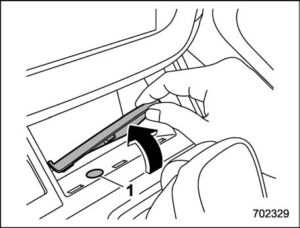
- Wrap the tip of a flat-head screwdriver with vinyl tape or cloth and use it to remove the shift lock cover. The shift lock release button is located under the shift lock cover.
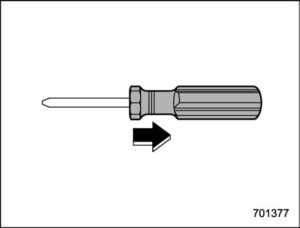
- While depressing the brake pedal, insert a screwdriver into the hole, press the shift lock release button using a screwdriver, and then move the select lever.

If the select lever does not move after performing the above procedure, the shift lock system may malfunction. Contact a SUBARU dealer for an inspection as soon as possible.
Selection of manual mode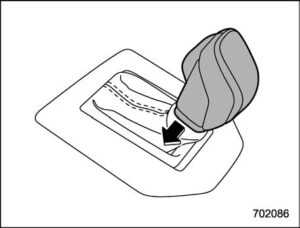
With the vehicle either moving or stationary, move the select lever from the “D” position to the “M” position to select the manual mode.
- Upshift indicator
- Downshift indicator
- Gear position indicator
When the manual mode is selected, the gear position indicator and upshift indicator and/or downshift indicator on the combination meter illuminate. The gear position indicator shows the currently selected gear in the 1st-to-7thgear range. The upshift and downshift indicators show when a gear shift is possible. When the upshift indicator “ ” illuminates, upshifting is possible. When the downshift indicator “ ” illuminates, downshifting is possible. When both indicators illuminate, upshifting and downshifting are both possible. When the vehicle stops (for example, at traffic signals) the gear will be automatically shifted to the 1st position and the downshift indicator will turn off. Gearshifts can be performed using the shift paddle behind the steering wheel.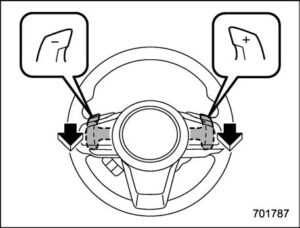
To upshift to the next higher gear position, pull the shift paddle that has “+” indicated on it. To downshift to the next lower gear position, pull the shift paddle that has “−” indicated on it. To deselect the manual mode, return the select lever to the “D” position from the “M” position. While driving with the select lever in the “D” position, if you change gears by operating the shift paddle, the gear position indicator light illuminates and shows the current gear condition.
CAUTION
Do not place or hang anything on the shift paddles. Doing so may result in accidental gear shifting.
NOTE
Please read the following points carefully and bear them in mind when using the manual mode.
- If you attempt to shift down when the engine speed is too high, i.e., when a downshift pushes the tachometer needle beyond the red zone, beeps will be emitted to warn you that the downshift is not possible.
- If you attempt to shift up when the vehicle speed is too low, the transmission will not respond.
- You can perform a skip shift (for example, from 4th to 2nd) by operating the shift paddle twice in rapid succession.
- The transmission automatically selects 1st gear when the vehicle stops moving.
- If the temperature of the transmission fluid becomes too high, the “AT OIL TEMP” warning light on the combination meter will illuminate. Immediately stop the vehicle in a safe location and let the engine idle until the warning light turns off.
Driving Tips
NOTE
Selection of “L” (if equipped)
“L” is for using engine braking when going down a hill, etc. To select this mode, move the select lever from the “D” position to the “L” position
When selected, the indicator “L” will illuminate on the combination meter. To deselect “L”, move the select lever to the “D” position.
If the accelerator and brake pedals are depressed at the same time, driving torque may be restrained. This is not a malfunction.
- On a road surface where there is a risk of wheelspin (for example, a snow- or gravel-covered road), you can pull away from a standstill safely and easily by first selecting the 2nd gear of the manual mode.
- Always apply the foot or parking brake when the vehicle is stopped in the “D” or “R” position.
- Make sure to apply the parking brake when parking your vehicle. Do not hold the vehicle with only the transmission.
- Do not keep the vehicle in a stationary position on an uphill grade by using the “D” position. Use the brake instead.
- The engine may, on rare occasions, knock when the vehicle rapidly accelerates or rapidly pulls away from a standstill. This phenomenon does not indicate a malfunction.
SI-DRIVE
SI-DRIVE (SUBARU Intelligent Drive) works to maximize engine performance, control and efficiency. This system consists of two modes: Intelligent (I), Sport (S), and Sport Sharp (S#). By operating the SI-DRIVE switches, the character of the power unit changes.
Intelligent (I) mode
For smooth, efficient performance driving

The linear acceleration characteristic of the Intelligent (I) mode is ideal for normal driving usage. The Intelligent (I) mode provides well-balanced performance with greater fuel efficiency and smooth drive ability without stress. Power delivery is moderate during acceleration for maximum fuel efficiency. This is ideal for around-town driving and situations that do not require full power output. It provides better control in difficult driving conditions, such as slippery roads
or loose surfaces, due to gentler throttle response.
Sport (S) mode (if equipped)
For all-around performance driving
For sports-minded drivers, the Sport Sharp (S#) mode offers an exhilarating level of engine performance and control. The throttle becomes more responsive regardless of the engine speed. Delivering maximum driving enjoyment, this mode is ideal for tackling twisting roads and for merging or overtaking other vehicles on the freeway with confidence.
SI-DRIVE switches
If any of the SI-DRIVE indicator lights blink, the SI-DRIVE system may be malfunction. Contact your SUBARU dealer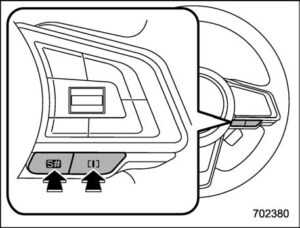
SI-DRIVE switches
To select the Intelligent (I) mode, press the “I” switch. To select the Sport (S) mode, press the “S” switch.
NOTE
- While the engine is cool, you cannot change to Sport Sharp (S#) mode.
- The next time you turn on the engine, after you turn off the engine in the Sport Sharp (S#) mode, the SI-DRIVE mode changes to the Intelligent (I) mode.
- While the engine is running, if the CHECK ENGINE warning light/malfunction indicator light illuminates, the SI-DRIVE mode changes to the Intelligent (I) mode. In this case, it is not possible to change to another mode. . If any of the SI-DRIVE indicators blink, the SI-DRIVE system may be malfunction. Contact your SUBARU dealer.
FAQ
It features a Continuously Variable Transmission (CVT).
The CVT offers smooth, seamless acceleration and improves fuel efficiency by constantly adjusting to deliver the optimal power band.
The CVT in the Touring XT is similar to other models but may be tuned to complement the turbocharged engine’s performance.
Yes, it typically includes a manual mode with paddle shifters, offering simulated gear changes for a more engaged driving experience.
By continuously adjusting the gear ratio for optimal performance, the CVT helps maintain efficient engine operation, enhancing fuel economy.
The Touring XT is equipped with a 2.4-liter turbocharged BOXER engine.
Regular maintenance is recommended, following Subaru’s service schedule, which may include fluid checks and changes.
It provides smooth and linear acceleration, effectively utilizing the turbo engine’s power.
Yes, driving modes can alter the CVT’s response, adjusting shift patterns for a sportier or more economical drive.
The CVT adjusts to maintain optimal power delivery, ensuring stable performance on inclines and declines.
It may include features like adaptive shift control, and optimizing performance based on driving conditions and style.
It works in tandem with the AWD system to provide smooth power delivery and traction in various conditions.
Benefits include smoother acceleration, better fuel economy, and a generally quieter operation.
Yes, especially with the manual mode and paddle shifters, drivers can enjoy a more engaged and sporty driving experience.
Technologies like adaptive cruise control and lane-keeping assist may interact with the CVT for smoother operation in traffic and on highways.
Useful Link
View Full User Guide: Subaru Legacy 2023 Touring XT User Guide
Download Manuals: https://www.subaru.com/owners/vehicle-resources/manuals.html
2024 Subaru Legacy Specs, Price, Features, Mileage (Brochure)


